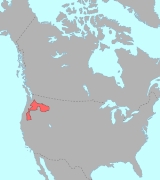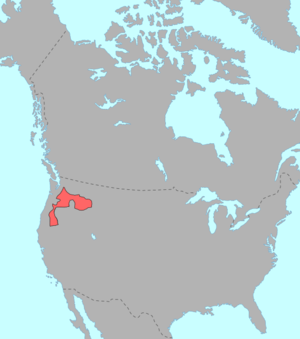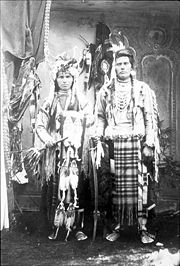
Nez Perce language
Encyclopedia
Nez Perce also spelled Nez Percé, is a Sahaptian
language related to the several dialects of Sahaptin
(note the spellings, -ian vs. -in). The Sahaptian sub-family is one of the branches of the Plateau Penutian
family (which in turn may be related to a larger Penutian
grouping). It is spoken by the Nez Perce tribe of the northwestern United States
.
Nez Perce is a highly endangered language
. While sources differ on the exact number of fluent speakers, it is almost definitely under 100. The Nez Perce tribe is endeavoring to reintroduce the language into native usage through a revitalization
program, though at present the future of the Nez Perce language is far from assured.
The grammar
of Nez Perce has been described in a grammar (Aoki 1970) and a dictionary (Aoki 1994) with two dissertations (Rude 1985; Crook 1999).
 The phonology
The phonology
of Nez Perce includes vowel harmony
(which was mentioned in Noam Chomsky
& Morris Halle
's The Sound Pattern of English
), as well as a complex stress
system described by Crook (1999).
 As in many other Native American languages, a Nez Perce verb can have the meaning of an entire sentence in English. (This manner of providing a great deal of information in one word is called polysynthesis
As in many other Native American languages, a Nez Perce verb can have the meaning of an entire sentence in English. (This manner of providing a great deal of information in one word is called polysynthesis
.) Verbal morpheme
s provide information about the person
and number
of the subject
and object
, as well as tense
and aspect
(e.g., whether or not an action has been completed).
, a morpheme that shows the function of the word (compare to English he vs. him vs. his). Nez Perce employs a three-way case-marking strategy: a transitive subject, a transitive object, and an intransitive subject are each marked differently. Nez Perce is thus an example of the very rare type of tripartite language
s (see morphosyntactic alignment
).
Because of this case marking, the word order can be quite free. A specific word order tells the hearer what is new information (focus) versus old information (topic), but it does not mark the subject and the object (in English, word order is fixed — subject–verb–object).
Sahaptian languages
Sahaptian is a sub-grouping of two languages of the Plateau Penutian family spoken by Native American peoples in the Columbia Plateau region of Washington, Oregon, and Idaho in the northwestern United States.-Family division:Sahaptian includes 2 languages*Kittitas *Klickitat*Nez Percé**Nez Percé...
language related to the several dialects of Sahaptin
Sahaptin language
Sahaptin , Sħáptənəxw, is a Plateau Penutian language of the Sahaptian branch spoken in a section of the northwestern plateau along the Columbia River and its tributaries in southern Washington, northern Oregon, and southwestern Idaho....
(note the spellings, -ian vs. -in). The Sahaptian sub-family is one of the branches of the Plateau Penutian
Plateau Penutian languages
-History:Plateau Penutian as originally proposed was one branch of the hypothetical Penutian phylum as proposed by Edward Sapir. The original proposal also included Cayuse ; however, this language has little documentation and that which is documented is inadequately recorded...
family (which in turn may be related to a larger Penutian
Penutian languages
Penutian is a proposed grouping of language families that includes many Native American languages of western North America, predominantly spoken at one time in Washington, Oregon, and California. The existence of a Penutian stock or phylum has been the subject of debate among specialists. Even the...
grouping). It is spoken by the Nez Perce tribe of the northwestern United States
United States
The United States of America is a federal constitutional republic comprising fifty states and a federal district...
.
Nez Perce is a highly endangered language
Endangered language
An endangered language is a language that is at risk of falling out of use. If it loses all its native speakers, it becomes a dead language. If eventually no one speaks the language at all it becomes an "extinct language"....
. While sources differ on the exact number of fluent speakers, it is almost definitely under 100. The Nez Perce tribe is endeavoring to reintroduce the language into native usage through a revitalization
Language revival
Language revitalization, language revival or reversing language shift is the attempt by interested parties, including individuals, cultural or community groups, governments, or political authorities, to reverse the decline of a language. If the decline is severe, the language may be endangered,...
program, though at present the future of the Nez Perce language is far from assured.
The grammar
Grammar
In linguistics, grammar is the set of structural rules that govern the composition of clauses, phrases, and words in any given natural language. The term refers also to the study of such rules, and this field includes morphology, syntax, and phonology, often complemented by phonetics, semantics,...
of Nez Perce has been described in a grammar (Aoki 1970) and a dictionary (Aoki 1994) with two dissertations (Rude 1985; Crook 1999).
Phonology

Phonology
Phonology is, broadly speaking, the subdiscipline of linguistics concerned with the sounds of language. That is, it is the systematic use of sound to encode meaning in any spoken human language, or the field of linguistics studying this use...
of Nez Perce includes vowel harmony
Vowel harmony
Vowel harmony is a type of long-distance assimilatory phonological process involving vowels that occurs in some languages. In languages with vowel harmony, there are constraints on which vowels may be found near each other....
(which was mentioned in Noam Chomsky
Noam Chomsky
Avram Noam Chomsky is an American linguist, philosopher, cognitive scientist, and activist. He is an Institute Professor and Professor in the Department of Linguistics & Philosophy at MIT, where he has worked for over 50 years. Chomsky has been described as the "father of modern linguistics" and...
& Morris Halle
Morris Halle
Morris Halle , is a Latvian-American Jewish linguist and an Institute Professor and professor emeritus of linguistics at the Massachusetts Institute of Technology...
's The Sound Pattern of English
The Sound Pattern of English
The Sound Pattern of English is a 1968 work on phonology by Noam Chomsky and Morris Halle. It presents a comprehensive view of the phonology of English, and stands as a landmark both in the field of phonology and in the analysis of the English language...
), as well as a complex stress
Stress (linguistics)
In linguistics, stress is the relative emphasis that may be given to certain syllables in a word, or to certain words in a phrase or sentence. The term is also used for similar patterns of phonetic prominence inside syllables. The word accent is sometimes also used with this sense.The stress placed...
system described by Crook (1999).
Consonants
| Bilabial Bilabial consonant In phonetics, a bilabial consonant is a consonant articulated with both lips. The bilabial consonants identified by the International Phonetic Alphabet are:... |
Dental | Alveolar Alveolar consonant Alveolar consonants are articulated with the tongue against or close to the superior alveolar ridge, which is called that because it contains the alveoli of the superior teeth... |
Postalveolar Postalveolar consonant Postalveolar consonants are consonants articulated with the tongue near or touching the back of the alveolar ridge, further back in the mouth than the alveolar consonants, which are at the ridge itself, but not as far back as the hard palate... |
Palatal Palatal consonant Palatal consonants are consonants articulated with the body of the tongue raised against the hard palate... |
Velar Velar consonant Velars are consonants articulated with the back part of the tongue against the soft palate, the back part of the roof of the mouth, known also as the velum).... |
Uvular Uvular consonant Uvulars are consonants articulated with the back of the tongue against or near the uvula, that is, further back in the mouth than velar consonants. Uvulars may be plosives, fricatives, nasal stops, trills, or approximants, though the IPA does not provide a separate symbol for the approximant, and... |
Glottal Glottal consonant Glottal consonants, also called laryngeal consonants, are consonants articulated with the glottis. Many phoneticians consider them, or at least the so-called fricative, to be transitional states of the glottis without a point of articulation as other consonants have; in fact, some do not consider... |
|||||
|---|---|---|---|---|---|---|---|---|---|---|---|---|
| (lateral Lateral consonant A lateral is an el-like consonant, in which airstream proceeds along the sides of the tongue, but is blocked by the tongue from going through the middle of the mouth.... ) |
central | lateral Lateral consonant A lateral is an el-like consonant, in which airstream proceeds along the sides of the tongue, but is blocked by the tongue from going through the middle of the mouth.... |
plain | lab. Labialisation Labialization is a secondary articulatory feature of sounds in some languages. Labialized sounds involve the lips while the remainder of the oral cavity produces another sound. The term is normally restricted to consonants. When vowels involve the lips, they are called rounded.The most common... |
plain | lab. | ||||||
| Nasal Nasal consonant A nasal consonant is a type of consonant produced with a lowered velum in the mouth, allowing air to escape freely through the nose. Examples of nasal consonants in English are and , in words such as nose and mouth.- Definition :... |
plain | m | n | |||||||||
| glottalized Creaky voice In linguistics, creaky voice , is a special kind of phonation in which the arytenoid cartilages in the larynx are drawn together; as a result, the vocal folds are compressed rather tightly, becoming relatively slack and compact... |
m̰ | n̰ | ||||||||||
| Plosive | voiceless Voiceless In linguistics, voicelessness is the property of sounds being pronounced without the larynx vibrating. Phonologically, this is a type of phonation, which contrasts with other states of the larynx, but some object that the word "phonation" implies voicing, and that voicelessness is the lack of... |
p | t | c | k | kʷ | q | qʷ | ʔ | |||
| glottalic Ejective consonant In phonetics, ejective consonants are voiceless consonants that are pronounced with simultaneous closure of the glottis. In the phonology of a particular language, ejectives may contrast with aspirated or tenuis consonants... |
pʼ | tɬʼ | tʼ | cʼ | kʼ | kʷʼ | qʼ | qʷʼ | ||||
| Fricative Fricative consonant Fricatives are consonants produced by forcing air through a narrow channel made by placing two articulators close together. These may be the lower lip against the upper teeth, in the case of ; the back of the tongue against the soft palate, in the case of German , the final consonant of Bach; or... |
(voiceless Voiceless In linguistics, voicelessness is the property of sounds being pronounced without the larynx vibrating. Phonologically, this is a type of phonation, which contrasts with other states of the larynx, but some object that the word "phonation" implies voicing, and that voicelessness is the lack of... ) |
ɬ | s | ʃ | x | χ | h | |||||
| Approximant Approximant consonant Approximants are speech sounds that involve the articulators approaching each other but not narrowly enough or with enough articulatory precision to create turbulent airflow. Therefore, approximants fall between fricatives, which do produce a turbulent airstream, and vowels, which produce no... |
plain | w | l | j | ||||||||
| glottalized Creaky voice In linguistics, creaky voice , is a special kind of phonation in which the arytenoid cartilages in the larynx are drawn together; as a result, the vocal folds are compressed rather tightly, becoming relatively slack and compact... |
w̰ | l̰ | j̰ | |||||||||
Grammar

Polysynthetic language
In linguistic typology, polysynthetic languages are highly synthetic languages, i.e., languages in which words are composed of many morphemes. Whereas isolating languages have a low morpheme-to-word ratio, polysynthetic languages have extremely high morpheme-to-word ratios.Not all languages can be...
.) Verbal morpheme
Morpheme
In linguistics, a morpheme is the smallest semantically meaningful unit in a language. The field of study dedicated to morphemes is called morphology. A morpheme is not identical to a word, and the principal difference between the two is that a morpheme may or may not stand alone, whereas a word,...
s provide information about the person
Grammatical person
Grammatical person, in linguistics, is deictic reference to a participant in an event; such as the speaker, the addressee, or others. Grammatical person typically defines a language's set of personal pronouns...
and number
Grammatical number
In linguistics, grammatical number is a grammatical category of nouns, pronouns, and adjective and verb agreement that expresses count distinctions ....
of the subject
Subject (grammar)
The subject is one of the two main constituents of a clause, according to a tradition that can be tracked back to Aristotle and that is associated with phrase structure grammars; the other constituent is the predicate. According to another tradition, i.e...
and object
Object (grammar)
An object in grammar is part of a sentence, and often part of the predicate. It denotes somebody or something involved in the subject's "performance" of the verb. Basically, it is what or whom the verb is acting upon...
, as well as tense
Grammatical tense
A tense is a grammatical category that locates a situation in time, to indicate when the situation takes place.Bernard Comrie, Aspect, 1976:6:...
and aspect
Grammatical aspect
In linguistics, the grammatical aspect of a verb is a grammatical category that defines the temporal flow in a given action, event, or state, from the point of view of the speaker...
(e.g., whether or not an action has been completed).
| word: | |
| morphemes: | |
| gloss: | 1/2-3OBJ - fire - fly - grab - straight.through - go.away - IMPERF.PRES.SG |
| translation: | 'I go to scoop him up in the fire' (Cash Cash 2004:24) |
| word: | |
| morphemes: | |
| gloss: | 3SUBJ - in.rain - come - PAST |
| translation: | 'He arrived in the rain' (Aoki 1979) |
Case
In Nez Perce, the subject of a sentence, and the object when there is one, can each be marked for grammatical caseGrammatical case
In grammar, the case of a noun or pronoun is an inflectional form that indicates its grammatical function in a phrase, clause, or sentence. For example, a pronoun may play the role of subject , of direct object , or of possessor...
, a morpheme that shows the function of the word (compare to English he vs. him vs. his). Nez Perce employs a three-way case-marking strategy: a transitive subject, a transitive object, and an intransitive subject are each marked differently. Nez Perce is thus an example of the very rare type of tripartite language
Tripartite language
A tripartite language, also called an ergative–accusative language, is one that treats the subject of an intransitive verb, the subject of a transitive verb, and the object of a transitive verb each in different ways...
s (see morphosyntactic alignment
Morphosyntactic alignment
In linguistics, morphosyntactic alignment is the system used to distinguish between the arguments of transitive verbs and those of intransitive verbs...
).
Because of this case marking, the word order can be quite free. A specific word order tells the hearer what is new information (focus) versus old information (topic), but it does not mark the subject and the object (in English, word order is fixed — subject–verb–object).
External links
- Phillip Cash Cash website (Nez Perce researcher)
- Nez Perce sounds
- Joseph Red Thunder: Speech of August 6, 1989 at the Big Hole National Battlefield Commemorating our Nez Perce Ancestors (has audio)
- Hinmatóowyalahtq'it: Speech of 1877 as retold by Jonah Hayes (ca. 1907) (.mov)
- Fox narrative animation (.swf)
- Nez Perce Verb Morphology (.pdf)
- wéeyekweʔnipse ‘to sing one’s spirit song’: Performance and metaphor in Nez Perce spirit-singing (.pdf)
- (.pdf)
- A map of American languages (TITUS project)
- Nez Percé at the Rosetta ProjectRosetta ProjectThe Rosetta Project is a global collaboration of language specialists and native speakers working to develop a contemporary version of the historic Rosetta Stone to last from 2000 to 12,000 AD; it is run by the Long Now Foundation. Its goal is a meaningful survey and near permanent archive of 1,500...
Vowel harmony
- Chomsky, Noam; & Halle, Morris. (1968). Sound pattern of English (pp. 377–378). Studies in language. New York: Harper & Row.
- Hall, Beatrice L.; & Hall, R. M. R. (1980). Nez Perce vowel harmony: An Africanist explanation and some theoretical consequences. In R. M. Vago (Ed.), Issues in vowel harmony (pp. 201–236). Amsterdam: John Benjamins.
- Kim, Chin. (1978). 'Diagonal' vowel harmony?: Some implications for historical phonology. In J. Fisiak (Ed.), Recent developments in historical phonology (pp. 221–236). The Hague: Mouton.

